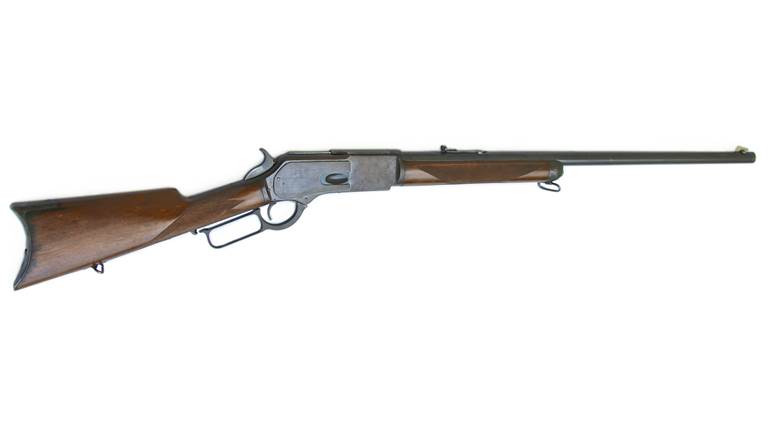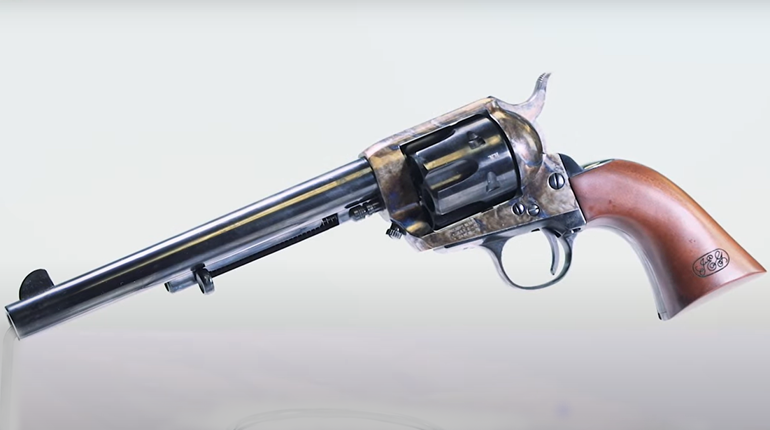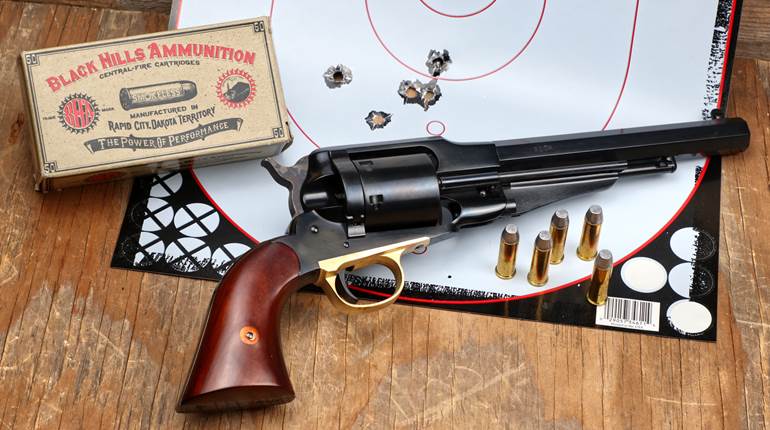
Even though CNC technology is used on most of its guns, Pedersoli still applies a lot of hand work. Cimarron made this customized, special-order 1871-72 Open Top in .44 Colt, featuring period engraving and fancy-grade, one-piece walnut stocks. The accompanying Slim Jim holster was made by El Paso Saddlery (epsaddlery.com).
At the 1983 NRA Annual Meetings in Phoenix, Ariz., history was made in more ways than one. Not only was President Ronald Reagan, an NRA Life member, the keynote speaker, but Mike and Mary Lou Harvey, owners of a Houston, Texas, sporting goods store, were about to make a decision that would have a profound and lasting effect on practically anyone who collects or shoots 19th century replica firearms today.
A few years previously, Mike had become a distributor for Leonard Allen, a major U.S. importer of Uberti replica revolvers and rifles. Now Mike and Mary Lou were about to purchase Allen’s company, which would make them one of the nation’s leading Uberti firearm distributors and dealers. With his penchant for detail, Mike had already contributed to upgrading Uberti’s replicas, including having them re-locate the mandatory-but-distracting governmental proofmarks to less conspicuous areas, such as under the barrel. He also had sent the company, located in the historic Italian armsmaking capital of Brescia, original cap-and-ball revolvers and Colt Single Action Armys from his personal collection so they could better duplicate the look and feel of the originals.
Mike and Mary Lou’s new company, re-branded as Cimarron Firearms, was launched in 1984 and, true to its name, has become known for creating classic, authentically styled guns of the Old West, not only from Uberti, but from other replica gun makers as well. In fact, their combination of both mechanical and historical innovations—differences both subtle and apparent—has set Cimarron apart from other replicas. In fact, the company is now the go-to source for Hollywood as it continues to wrangle the box office revenue good Westerns have always returned. (For more on the connection between Cimarron and Tinseltown, visit americanrifleman.org/cimarron-stars).

The Harveys’ insistence on authentic detail is relentless. For example, the “Cimarron F.A.” nomenclature on its Model P single-action barrels is roll-stamped in the same length, height and type style as the lettering on pre-war Colts. “We had our own marking dies made and even copied the lettering style found on the originals,” said Mike. “We even counted the characters in each line and matched the length of our stampings to the length and height of the originals. That’s one of the things that make our guns stand out—we demand that the guns look authentic.” Cimarron was also the first to put the original patent dates on SAA frames, and its revolvers are the only guns that Uberti produces with period-correct nitre-blued screws, in addition to being the first to offer an antiqued “Original” finish on its revolvers. Additionally, even though the latest CNC and computer-controlled techniques are employed, the forged Uberti single-action frames receive 30 different polishings, many of which are accomplished by hand and with leather straps, duplicating some of the gunmaking procedures of more than a century ago. And, because Italian law forbids the use of animal bone in the case-hardening process, Mike elects to have some of his guns case-hardened in the United States to achieve an authentic 19th century rainbow hue.
As an alternative to the hammer-block transfer bar found on most of today’s single-actions, with its telltale squared-off hammer profile, Mike devised an alternate concept of a trigger block safety by positioning a shorter transfer bar, spring and firing pin arrangement inside the hammer of some Uberti single-actions, where it can’t be seen. This system blocks the trigger from tripping the hammer until the gun is fully cocked, yet permits a non-ridged Colt-style firing pin to be visible in a “natural-looking” hammer contour when cocked, allowing all six rounds to be safely loaded in the cylinder. This feature is incorporated on Cimarron and other Uberti–made single-actions.

Uberti, now owned by Beretta Holding Co., isn’t the only Cimarron manufacturer today, although it remains their largest supplier, producing Cimarron’s cap-and-ball revolvers and many of its Model P-style single-actions and lever-action Henry and Model 1873 rifles. Mike also works closely with the other three top replica gun factories in Brescia, each selected for its specific areas of expertise: Chiappa creates Cimarron’s Spencer-style rifles—now produced with authentic Spencer stampings, as Cimarron has trademarked the name. In addition to .45 Colt, Spencer rifles will also soon be offered in the historically correct .56-56 Spencer chambering. Chiappa also produces Cimarron’s Model 92 lever-actions and its Model 1887 lever-action shotgun. Davide Pedersoli manufactures Cimarron’s single-shot “Trapdoor” Springfield and Sharps rifles, along with the Model 1886 and Model 71 lever-actions. Pietta, with a proficiency in laser engraving, creates a number of Cimarron’s commemoratives and other laser-engraved firearms.
Cimarron also imports a World War I-era replica M1911, in .45 ACP, made in the Philippines by Armscor. Clearly, though, its 19th century reproductions that have established the company’s reputation, most noticeably among cowboy action shooters, re-enactors and the motion picture industry, as well as hunters, plinkers, and other aficionados of 19th century-style firearms who demand the utmost in craftsmanship and authenticity.
Sadly, Mary Lou Harvey passed away a few years ago after a courageous battle with cancer, and today the company is headed by Mike, assisted by his daughter Jamie, who serves as Cimarron’s vice president of media, and her husband, Bryce Wayt, vice president of retail operations for the company’s Texas Jack Wild West Outfitter subsidiary.
Having followed Cimarron since its inception—when the guns were first being imported under the Western Firearms label (which was then changed to Allen Firearms to resolve a legal dispute with Winchester-Western Ammunition)—I decided to accompany Mike on one of his annual trips to Brescia to see how a down-home Texas boy with an easy-going drawl was able to achieve such exacting results from the four highly respected firearms firms.
“Each factory has its own personality, its own vibe,” Wayt said on the first day of our trip, as we entered the sprawling Uberti factory located within the massive Beretta industrial complex in Gardone—a suburb of Brescia—where Beretta was founded in 1526. With approximately 60 employees, Uberti is the largest Italian producer of 19th century replicas. This was evident by the numerous gun parts that were arranged along multiple rows of benches manned by workers who were surrounded by rifles and pistols in various stages of assembly, from stock and action fitting to barrel adjustments, most of which were being done by hand. The automated and highly specialized computerized machining operations were in another part of the factory. And although each worker was intently concentrating on one specific task, most were capable of assembling an entire gun, from start to finish. This is what it must have been like in Colt’s old Hartford factory, I thought.

That image was reinforced when we entered Uberti’s spacious conference room, its walls covered with posters of Italian and American western movies that had featured Uberti guns. In addition, gun racks and a huge, glass-topped conference table displayed numerous Uberti single-actions and lever-actions, giving the room the semblance of an 1880s gun store.
The frontier ambiance of the room was further accented by the faint sporadic sounds of gunfire. But it wasn’t from a high-noon showdown on Main Street; rather, it was coming from Beretta’s underground testing range. For anyone enamored with Sergio Leone’s Spaghetti Westerns, this room was nirvana. That feeling culminated when I was introduced to Giacomo Merlino, managing director of A. Uberti, for as we shook hands, I distinctly heard the haunting strains of the theme from “The Good, the Bad, and the Ugly.” But it wasn’t my imagination; it was the ring tone from Giacomo’s cell phone, as someone was calling him at that exact moment.
Speaking of Spaghetti Westerns, Uberti makes one of Cimarron’s most popular handguns, an 1851 Navy conversion in .38 Spl. that replicates the sixgun—complete with silver coiled-rattlesnake-inletted stocks—deftly wielded by Clint Eastwood’s “The Man With No Name” in Leone’s famous Italian-western trilogy: “A Fistful of Dollars,” “For A Few Dollars More” and “The Good, the Bad, and the Ugly.” But unlike the movie gun, Cimarron’s version sports a couple of improvements that make it more practical: a fixed rear sight dovetailed into the rear of the barrel and a Harvey-designed removable rod concealed in the rammer so that empty cases can be punched out of the cylinder.
“At first I didn’t think a gun like this would sell,” Mike admitted, “because it’s basically our blackpowder 1851 Navy and still had the rammer, which would be useless in a cartridge conversion. But I kept getting calls for it—a lot of calls—so I finally told Uberti we would just do a run of 500, because we might not sell any more. But when we announced the gun six months prior to production, we immediately got orders for over 500.”
The “Man With No Name” ’51 Navy cartridge conversion has become one of Cimarron’s most sought-after guns, along with its Single Action Army replicas and Model 1873 rifles and carbines. And as a bonus, all of Cimarron’s Uberti-made replicas now come with Stoeger’s warranty, which covers any Uberti firearm—including replacement parts and labor—for five years from the date of purchase by the original owner.
As Uberti is currently the only Italian company making a replica 1848 Walker, Mike revealed he will be bringing out 1,000 appropriately marked military Texas Walkers. And although the majority of Cimarron’s guns are historically correct, Mike is not averse to melding previously existing guns to create, to paraphrase the late motion-picture director John Ford, not what they were, but what they could have been. This was the philosophy behind Cimarron’s introduction of the Thunderer a few years ago, which paired a single-action Model P frame with an enhanced version of the Colt 1877 Thunderer’s bird’s head grip. And using a combination of pencil drawings, CNC machinery and 3D imagery along with some of Mike’s original guns, Uberti is now working on an improved version of an S&W American that will have the internal parts of a S&W Schofield, a gun already in its line.
“We do whatever Mike asks for because he’s the one who gives us all the ideas,” Giacomo said. “Mike knows all about the history of the guns, and he knows what he wants.”
Our next stop was at the spacious and modern Chiappa factory, where we were met by Rino Chiappa, whose late father started the family’s predecessor company, Armi Sport, in 1958. Rino changed the name to Chiappa in 2015 because he wanted the family name on the business, since two of his four children are now working at the factory. As we entered the showroom, we were met by Rino’s charming wife Susanna, standing alongside a life-size color cutout of John Wayne. Indeed, the spirit of the American West is alive and well in Italy. And no wonder—the U.S. accounts for 50 percent of Chiappa’s business, and it takes 45 other countries to make up the other half. With the recent purchase of a new laser and milling machine, Chiappa plans to ramp-up production even further.
The factory is flooded with natural light, but the window of Rino’s office faces inside, toward the workers and the machinery, so he can keep an eye on production at all times. Chiappa uses no external suppliers and all of its R&D, design, schematics, 3D printing of prototypes, CNC work, and of course, final manufacturing—including stock milling, finishing and fitting—is done in-house. Chiappa even owns the company that does the bluing and nickel plating, and has its own in-house shooting range for testing guns, including functioning prototypes they make from aluminum and steel. Working three shifts, 24 hours a day (except Sundays, when closed), Chiappa produces 2,000 guns each day, ranging from blank starter pistols to its Rhino revolver.
For Cimarron, in addition to the Spencer carbine and various lever-actions, Chiappa produces .22 single-action revolvers. Interestingly, guns sent to the Italian government proofhouse in Galdona del Trophe are temporarily fitted with “beater” stocks, but once they come back from proofing, they are re-stocked with high-grade European walnut and re-shot at Chiappa’s in-house range for a final quality control. Then they are cleaned, polished and inspected once more before being packed for shipping.
Like Chiappa, Davide Pedersoli is family-owned, having been started in 1957 by the late Davide Pedersoli. Today, the company is run by his son Pierangelo Pedersoli and Pierangelo’s son Stephano, and specializes in CNC-engineered 19th century replicas that are renowned for their accuracy. I experienced this firsthand with its trapdoor Springfield carbine and, more recently, with Cimarron’s Billy Dixon Officer’s Model—one of the most authentic on the market—featuring an engraved lockplate and an 1879 rear sight in addition to the folding tang sight found on other replicas.
One of the unique features of Pedersoli’s rifles is that they are all stocked with American walnut, rather than European wood. Pedersoli is also one of the few Italian companies that can produce full-length Kentucky rifle stocks. Pierangelo personally inspects every stock for grain quality and dimensions. It was here that I saw Mike’s penchant for detail, as he re-checked the length of pull on the Pedersoli-made Cimarron’s Model 71 rifles, which he had the factory adjust from 15" to 14", to make it more acceptable for American shooters. He also checked the radius of the curve on the Model 71 fore-ends, and specified a more authentic, reddish-brown stain for the walnut, which Pierangelo subsequently told me has now been adopted by other companies as well. The same situation occurred with Pedersoli’s case-coloring for Cimarron rifles, which Mike had altered to provide a more authentic appearance.

“The Italians have two different types of case-coloring,” Mike said. “One is case-coloring and one is case-coloring with added color. I told Pierangelo I wanted to add color, which they can do with chemicals, but they can’t use bone charcoal. Those chemicals are heated up to between 700 and 800 degrees, which is almost red hot. Then they’re quenched in cold water. And I think potassium is added to the water, which in turn gives the steel a darker color. So I had him do that on all of his guns for me. And as soon as another customer of his saw it, they had to have it, too.”
At Pietta, as was his custom throughout our trip, Mike opened the meeting by presenting Alberto and Alessandro Pietta—sons of company founder Giuseppe Pietta, who had also stopped in for a brief visit—with a bottle of Sweet Baby Ray’s Barbecue Sauce—a tasteful reminder of Cimarron’s American roots. Then he unexpectedly rolled a prototype of a .22 rimfire conversion cylinder for an 1858 Remington revolver across the conference table towards them and said, “Here, make this.” After a brief exchange of surprised glances, Alberto and Alessandro picked up the cylinder and studied it. Perhaps some day it will be in the Cimarron line.
For the present, though, Pietta is producing a number of Cimarron’s special laser-engraved and commemorative single-actions with some higher-end models embellished even further with hand-engraving, while still being able to keep prices competitive. Already available is Cimarron’s Texas Ranger Model P, a nickel-plated, laser-engraved single-action chambered in .45 Colt and sporting a 4¾" barrel. But what really sets this sixgun apart is the “C”-type Helfricht-style laser scrollwork. In addition, the ejector rod housing is prominently etched with the immortal Texas Ranger slogan, “One Riot, One Ranger.” Endorsed by the Former Texas Rangers Foundation, a portion of each Texas Ranger Model P sale is being donated by Cimarron for the development of the Texas Ranger Heritage Center. This handsome sixgun is now a regular part of the Cimarron line.
Another frontier firearm being made by Pietta for Cimarron is a replica of one of the two SAA revolvers Theodore Roosevelt packed while ranching in the Dakota Badlands during the 1880s. While not an exact copy—TR’s Colts were Nimschke-engraved, ivory-stocked, and silver-plated with gold-washed cylinders, hammers and ejector rods—Cimarron’s TR replica will be a laser-etched, nickel-plated, 7½"-barreled single-action with white Micarta stocks. In addition, there is a High Grade version featuring more finely detailed hand engraved accents to the laser etching. Both versions are chambered in .45 Colt, as opposed to TR’s guns, which were .44-40s. Also, watch for a matching engraved Teddy Roosevelt 1876 Sporting Rifle from Uberti.
Other Cimarron guns already available or soon to be introduced include a General George S. Patton laser-engraved Model P single-action featuring a pre-war frame, an engraved Buffalo Bill Model P, a World War II-style Model 97 trench gun, a recreation of a pre-’64 style Model 94 lever-action with a half-cock notch and no “floating hammer,” a shortened Model 1873 U.S. Marshal carbine in .44 Mag. for backpacking and car carry, and a copy of the five-shot 1862 Colt Police Pocket Conversion that will be, atypically, chambered in.380 ACP.
Indeed, Cimarron Firearms is not only setting standards and making replicas of the guns that won the west, it is creating innovations of guns that are re-winning the west for today’s shootists.
For more information, contact: Cimarron Firearms Co., 105 Winding Oak Road, Fredericksburg, TX 78624; (830) 997-9090; cimarron-firearms.com
Additional Reading:
Cimarron Comes to Hollywood





































